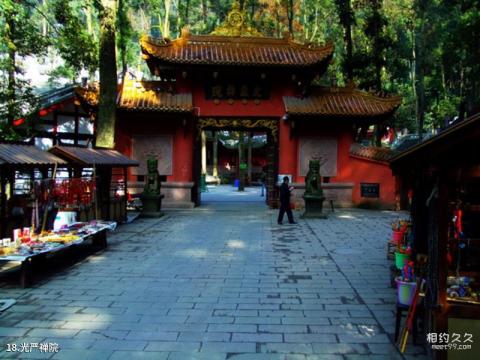
Introduction to Guangyan Zen Temple: Guangyan Zen Temple, formerly known as Changle Temple, is commonly known as the ancient temple. It is surrounded by the green peaks of Fengqi Mountain all year round. The ancient temple was built in the Sui Dynasty and rebuilt by monk Shansi in the Jiashen year (864) of Emperor Yizong of the Tang Dynasty. During the Ming and Qing dynasties, the ancient temple was deeply favored by the royal family. Monk "Faren", the uncle of Emperor Taizu Zhu Yuanzhang of the Ming Dynasty, became the abbot of the ancient temple after traveling to Tibet, India and other Buddhist holy places. After Zhu Chun, the king of Shu Xian, learned about it, he reported to Emperor Taizu of the Ming Dynasty to grant Faren the emblem of "Wukong". After the death of Zen Master Wukong, his body was placed in the Wukong Pagoda. It has been well preserved for more than 600 years. Unfortunately, it was destroyed during the Cultural Revolution. Fortunately, a local knowledgeable person took a photo of Wukong's body, which is now in the ancient temple and has become another treasure.
Zhu Yuanzhang once personally inscribed the four words "pure and undefiled" on the ancient temple. After Chengzu of the Ming Dynasty ascended the throne, it is said that Emperor Jianwen Zhu Yunwen took refuge there and gave the ancient temple "Guangyan Zen Temple", half a pair of Luan chariots and two imperial pots. As well as dragon and phoenix flags, glazed tiles, a Buddhist scripture "Hongwu Nanzang" and a piece of Indian Sanskrit Bay-leaf Sutra "Huayan Sutra". Among them, "Hongwu Nanzang" is a Buddhist classic engraved by Zhu Yuanzhang's order during the Hongwu period. It is a voluminous volume with more than 7,000 volumes in total. Only two volumes were printed after it was engraved, and one is stored in the Secret Pavilion of the National Library at that time (it was destroyed in the 6th year of Yongle's reign) Fire); a copy of the ancient temple given by the emperor is hidden in the Sutra Collection Building. This collection of sutras is the only one in existence in the country. It is said to be unparalleled and out of print. It is a treasure of the temple and is now in the Sichuan Provincial Library.
